PERIKLES (c. 490–429 BC) Ancient Greek politician, strategist...

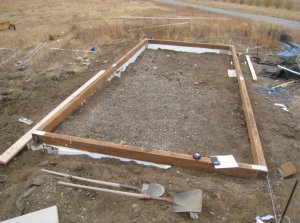
Today can see practically on all private land.
Nowadays, these buildings may have not only the standard, square or rectangular form, but also more bizarre designs.
In most cases, the appearance of a structure of the original form in the garden is due to the fact that it the owner is trying to stand out from the rest, making the greenhouse attractive. Frames made in the form of small pyramids are especially popular.
In contact with
Greenhouses in shape pyramids, is a geometric shape that used in the construction industry already enough for a long time. There are many assumptions explaining their popularity and very wide distribution.
However No one of the most exact argument capable of explaining why pyramid-shaped structures have become part of many land plots intended for the cultivation of a variety of greens, as well as vegetables, strawberries and even decorative flowers.
This design has many very important benefits. The main ones are the following:
There are no disadvantages of such greenhouses..
As materials for creating a do-it-yourself pyramid greenhouse frame, wooden beams can be used, plastic, polycarbonate and even metal elements.
Polyethylene film is often used to cover the greenhouse. But you can make a polycarbonate pyramid greenhouse, that is, the outer covering of the structure. However some owners land plots cover their glass sheets.
Photo of a do-it-yourself polycarbonate pyramid greenhouse:

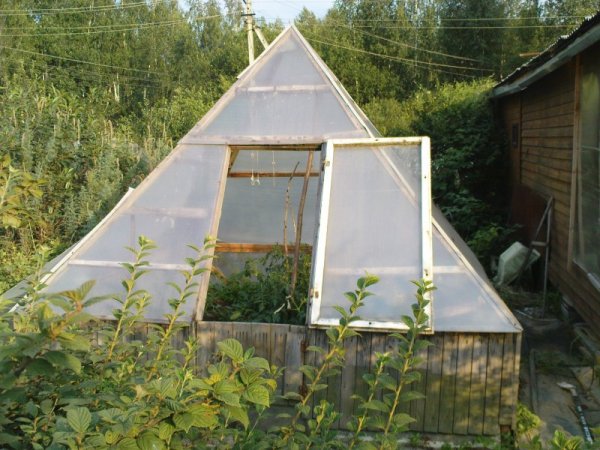

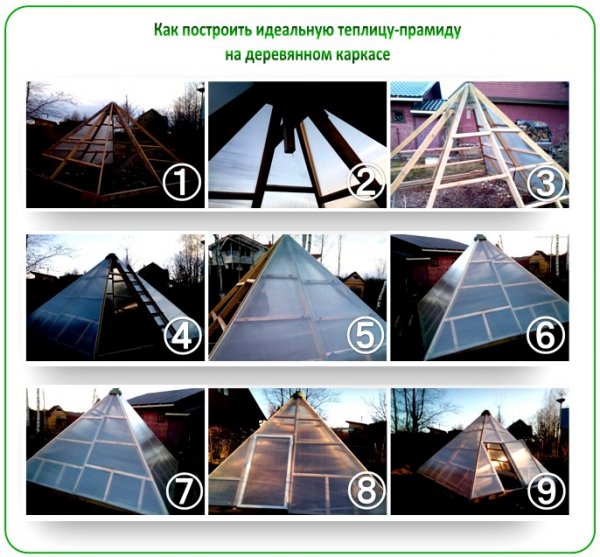
Before proceeding with the preparation of the drawing, need to size future building. In order for a pyramid-shaped greenhouse to be created according to all standards, the so-called " golden ratio» buildings.
Greenhouse "pyramid", the dimensions may be as follows: the most the best option is structure 3.2 m high from the surface of the earth. In this case, the base should have the following parameters - 1.42x1.42 m with a diagonal of 2 m. As a result, the size of the "golden section" will be 0.62 m.
Do-it-yourself drawing of a greenhouse-pyramid:
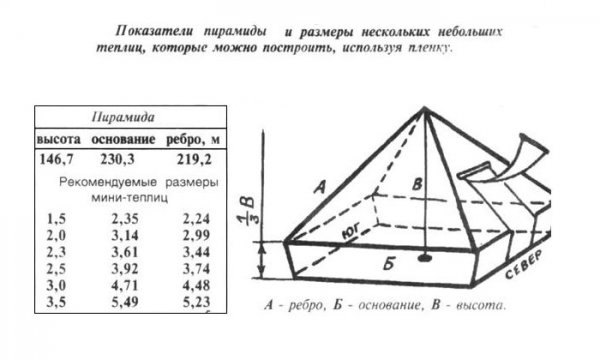
How to build a pyramid greenhouse with your own hands? Having given preference to the greenhouse-pyramid, you need to remember that the structure should be installed only along the north-south axis. This is due to the fact that there are natural magnetic fields that have exactly the same direction.
According to verified information, vegetables in these greenhouses ripen a few weeks earlier ordinary. In addition, they are distinguished by juiciness, a more pleasant taste and large sizes. In addition, even severe frosts and various diseases and insects do not touch the plants that grow in this greenhouse.
The site for the location of the building should be in a completely open space, and not close to the trees. This will provide better lighting of the greenhouse on each side throughout the day.
Usually, a foundation is made under the greenhouse, which improves the stability of the frame. To date there are several varieties such foundations:
Foundation from a bar is considered the simplest construction technology. Its main advantage is that it is easy to assemble and then assemble.
The block foundation is characterized not only by high strength, but also by excellent waterproofing properties. He ideal for pyramidal greenhouses made of either polyethylene film or polycarbonate sheets.
Brick foundations are considered the most reliable. However, for them an additional layer of waterproofing is required placed between the base of the foundation and the frame.
A slab foundation is constructed from small concrete blocks directly connected to one or more drainage wells.
Step-by-step instruction manufacturing a greenhouse in the shape of a pyramid:
To increase the strength of the greenhouse usually do a crate, however this is not a required step.
Greenhouses mounted in the form of small pyramids, attract attention with their originality. They can become a real decoration of a private land plot. Such greenhouses are intended for growing vegetables, herbs, strawberries or flowers, so this is an ideal option for almost every occasion.
Useful information about the pyramid greenhouse in the video below:
In contact with
See inaccuracies, incomplete or incorrect information? Do you know how to make an article better?
Would you like to suggest photos for publication on a topic?
Please help us make the site better! Leave a message and your contacts in the comments - we will contact you and together we will make the publication better!
Why the pyramid?
Fans of fantasy and all sorts of sensational secrets like the theme of the pyramids, because they find a lot of unusual things in them. The main reason for the injection of mystery is the fact that in different parts of the planet our distant ancestors built the same structures with a similar purpose.
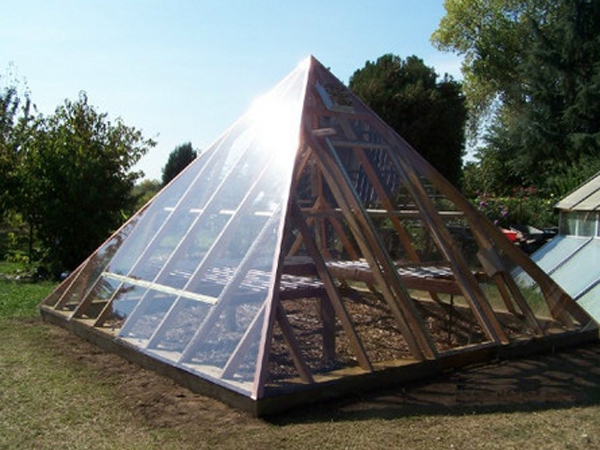
Pyramids with cult purposes have been found in Africa and Central America. Between these points for our distant ancestors there are insurmountable obstacles in the form of oceans and large spaces, so the ancestors could not communicate and adopt each other's technologies. The conclusion of science fiction fans suggests itself: it was aliens who landed and built a bunch of pyramids for some reason.
Meanwhile, there are other, more prosaic explanations. First, people actively moved from one continent to another. The main migration trajectory lay just from Africa through Asia to America. So there was someone to transfer knowledge.
Secondly, the pyramid is the easiest and most economical way to build non-residential premises. A child, when playing with cubes, builds, first of all, a pyramid, and aliens are unlikely to tell him this.
In Africa and Central America, they also played with cubes, but not with wooden ones, but with stone ones. These pyramids have stood up to our times precisely due to the fact that such a structure is poorly destroyed.
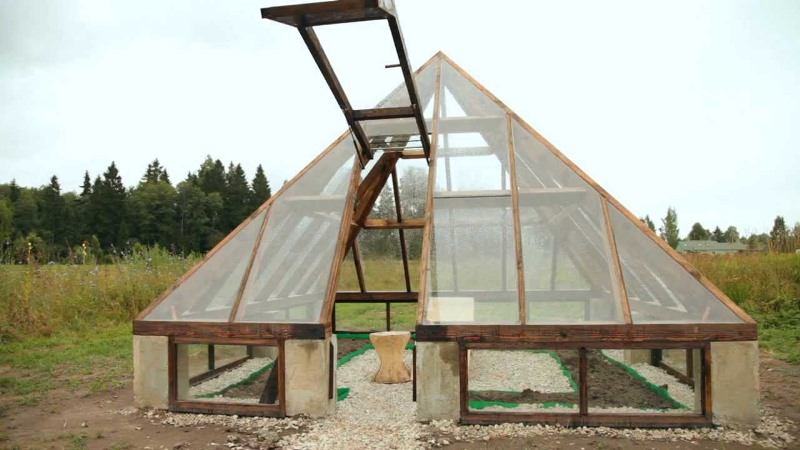
In addition, the pyramid is a crystal. Its facets concentrate the energy of the earth and the sun. For the same reason, mountain peaks are so attractive.
The pyramidal greenhouse is an idea that has absorbed rationality in construction and maximum efficiency in operation. Such a structure has increased stability. The greenhouse in the country suffers primarily from the wind. The higher the walls of such a structure, the more it turns into a yacht with a sail. The shape of the pyramid reduces the windage effect. This means that a strong wind will not destroy the structure and will not tear off the fixed film. At least the probability of this event is significantly reduced.
There are two more advantages: the pyramidal greenhouse is much better lit and warmed up than its four-walled counterparts. At the same time, it creates little shadow on the site. It is convenient to have a greenhouse in it, which can then be made into a garden bed.
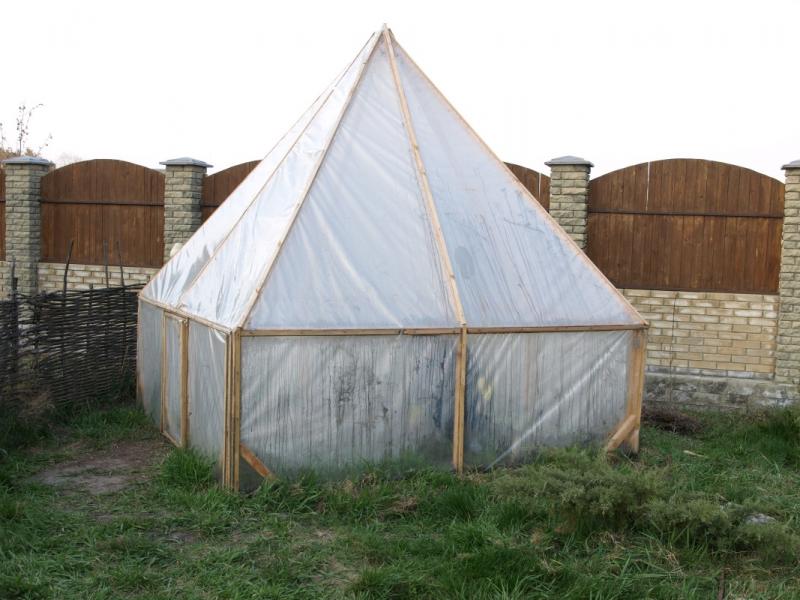
The only rational form of placing plants inside the greenhouse is a gradual increase in size from the periphery to the center. If tall plants are placed around the perimeter, then only creepers can be placed in the center, which go up to the ceiling along the trellises.
However, such an inconvenience stops few people, there are more and more people who want to install a pyramidal greenhouse.
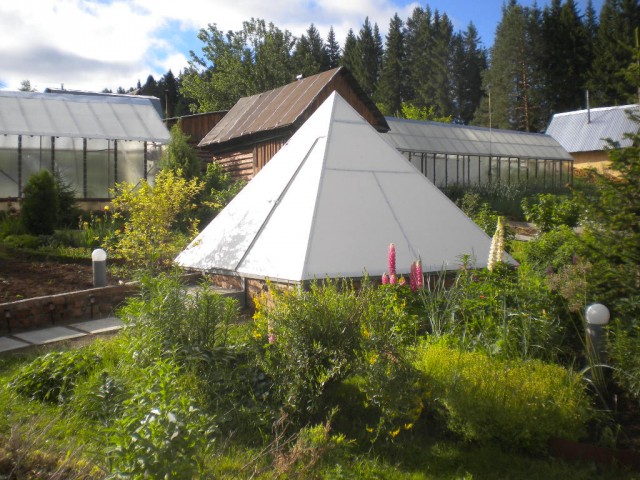
The fact is that the most important element of any pyramid is such a concept as the golden ratio. It is understood as the ratio of the diagonal of the base of the pyramid to its height. The most stable pyramid has a cross section of 0.62. This means that the pyramid greenhouse can have different sizes, but the proportions should be as follows.
Thus, any pyramids, including greenhouses, are subject to strict construction rules. The optimal proportions are calculated by the formula: height multiplied by a constant number of 1.57075. As a result, you will get the size of the side of the square base of the greenhouse.
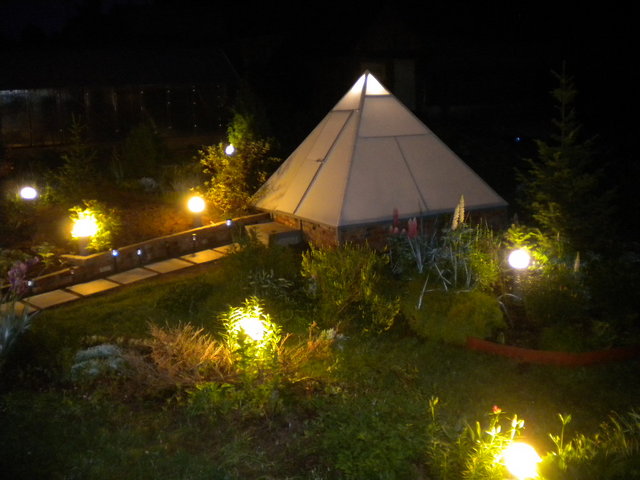
In the country, such a greenhouse can be made in a simplified form as follows:
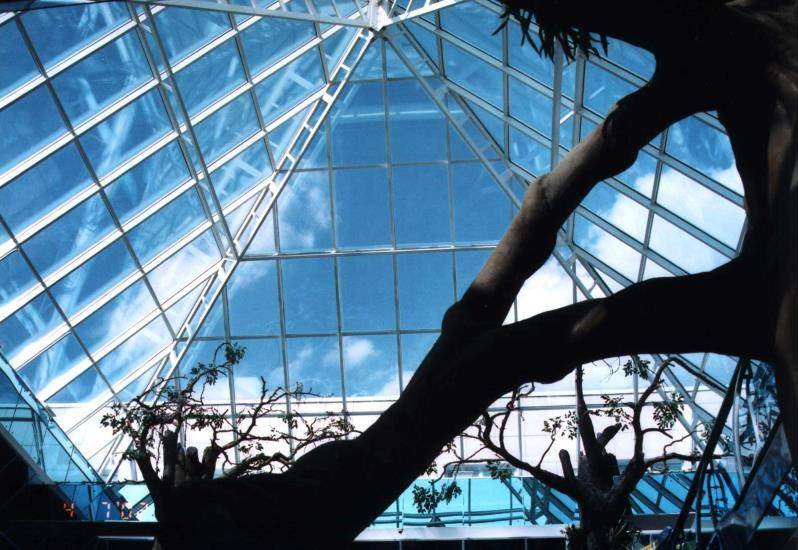
That's all, you made a pyramid with your own hands. It remains only to prepare the ground. At the heart of such a greenhouse, you can make a greenhouse. A small trench is dug along the perimeter with a depth of 30-50 centimeters, manure and a layer of hay are placed in it. From above, all this is covered with earth by about 50-70 cm. The result should be high bed in formwork made of wood, plastic and other materials. Seedlings can be grown here in early spring. After most of it has been transplanted into the open field, some, for example, tomatoes can be left to grow in a greenhouse to get early vegetables.
Such a pyramid is more difficult to install, but more reliable in operation. If the cottage is large, then you can build 2 greenhouses. One of them will serve as a frame over the greenhouse, seedlings can be transplanted into the other, receiving an additional crop.
A polycarbonate greenhouse creates optimal conditions for growing vegetable and flower seedlings, seedlings and vegetables, protecting them from the negative effects of the environment: sudden temperature fluctuations, gusts of wind, drought or long heavy rains, pests, fungal diseases. This article is devoted to how to build a pyramid-shaped polycarbonate greenhouse and what are its advantages not only for plants, but also for human health. To help those who want to build it with their own hands - detailed drawings.
The construction of a greenhouse begins with calculations to determine its size.
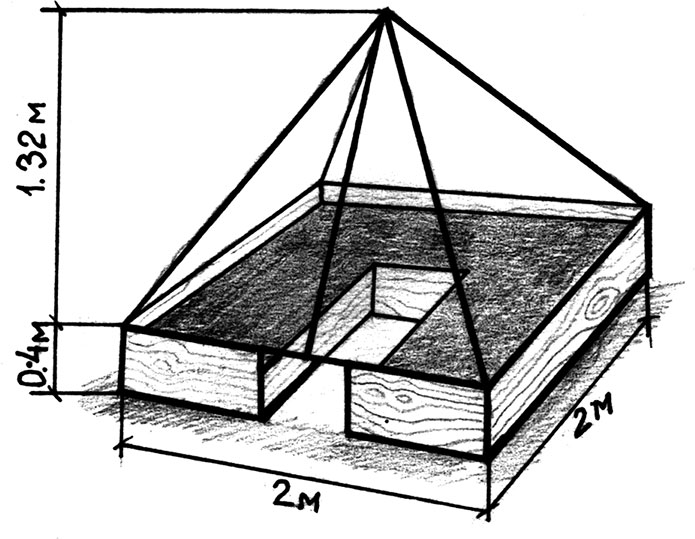
An example of a pyramid greenhouse with a base
Attention! It is not difficult to check the correctness of the calculations even at the planning stage. To do this, the diagonal of the base of the structure should be divided by its height, if the result is the number 0.62, then the calculations were carried out correctly.
The construction of a greenhouse structure consists of several stages:
1. Choosing a place for the future greenhouse device - it should be even, without holes and bumps. If there are any, the surface must be specially prepared: level the bumps, and fill the pits.
2. Mark the base of the future structure, taking into account the calculations.
3. At the point of intersection of the diagonals of the base, install the central support of the future structure of the greenhouse-pyramid.
Attention! For the central support of the future pyramid, a beam with a length should be used: the planned height of the greenhouse + 40-50 cm (by this value, the beam should be deepened into the soil, which will ensure the stability of the structure).
4. In the corners of the pyramid, dig 4 bars about 50 cm high and sew up the base of the future greenhouse along the perimeter with a tree, while not forgetting about the door, the frame of which must be placed on the south side of the greenhouse.
5. Using wooden beams or metal corners, connect the base of the pyramid (corner beams) to the top (central beam).
6. To increase the stability of the edges, you can additionally strengthen them with props.
7. Sew up the resulting structure with polycarbonate using the appropriate mounting hardware. To ensure the necessary ventilation, it is recommended to leave a space of about 15 cm unstitched. To close it at night, an appropriate cap is made, which is fixed with loops in the upper part of the structure.
The use of the foundation makes the structure more durable and stable, prolongs its service life.
The foundation for the future greenhouse can be tape or any other. To create a strip foundation, you must:
1. Mark the dimensions of the base of the greenhouse, and then dig trenches around the perimeter 25-35 cm wide and up to 50 cm deep.
2. Fill the bottom with sand, and then with gravel to a height of 5 cm, tamp. Lay a waterproofing film on the prepared pillow.
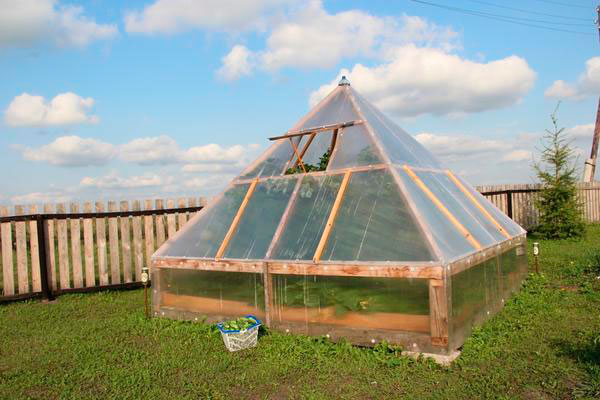
3. Install the formwork using old boards for it, close the formwork with foil.
Attention! The foundation should rise at least 20 cm above the ground, forming a low base.
4. Install reinforcement and 4 corner fastening elements of the future structure (metal corners).
5. Fill the formwork with concrete and leave to harden for 2 weeks
Once the foundation is ready, you can begin to assemble the frame of the greenhouse.
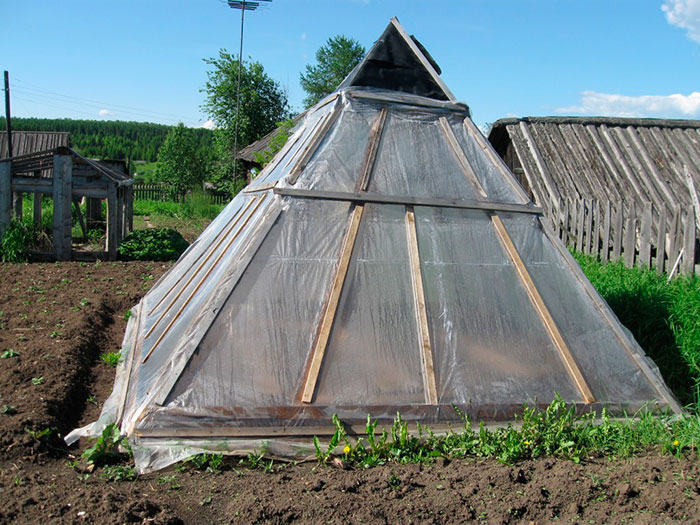
The use of polycarbonate to create a pyramidal greenhouse allows you to:
The pyramidal shape of the greenhouse has its advantages compared to other types of greenhouses:
1. The pyramidal design allows you to absorb the maximum amount of sunlight in the morning and evening hours and reflect its excess in the afternoon.
2. The height and compactness of the design allows you to maintain an optimal indicator of air humidity, if you place a container with water inside it, thereby contributing to the active development of plants, protecting them from the appearance of certain types of pests and fungal diseases.
Attention! As noted, tomatoes in such a greenhouse are not subject to late blight.
3. Carrying out pre-sowing treatment of seeds inside the pyramid greenhouse, and then planting them, gives more friendly seedlings and higher yields.
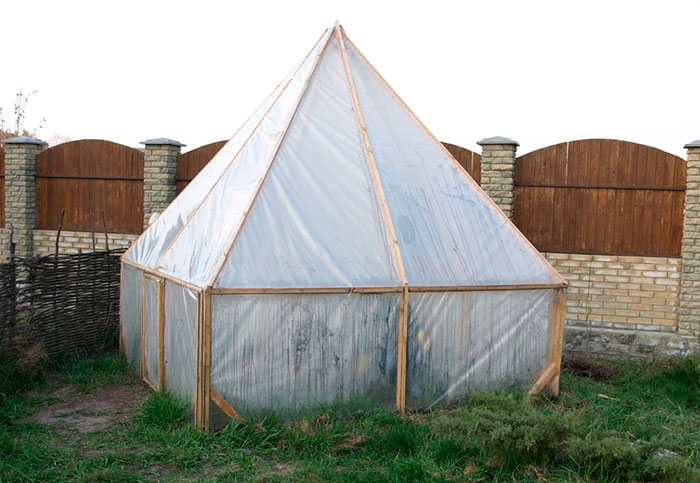
Staying in a greenhouse-pyramid energizes and energizes
4. The microclimate created inside the pyramidal greenhouse helps to lengthen the growing season for plants. Vegetables and herbs grown in a pyramid greenhouse are distinguished by their excellent taste and early term maturation.
Attention! As the experience of gardeners in pyramidal greenhouses shows, the yield of radishes and cucumbers is 40-50% higher compared to growing the same vegetables in open field. Tomatoes and peppers ripen 2 weeks faster, and their fruits are larger.
5. The pyramidal frame of the greenhouse is resistant to snowfall and wind.
6. If it is necessary to create conditions for a short daylight hours, it is convenient to cover the pyramidal greenhouse with dark material.
7. It has also been noticed that gardening in a pyramidal greenhouse improves mood and improves well-being, energizes, relieves the feeling of fatigue.
Building a greenhouse in the form of a polycarbonate pyramid does not require more skills, time and material costs, so anyone can do it. Due to its compactness, it can be placed even in a small area. And high ergonomic qualities make its operation very effective.
![]()
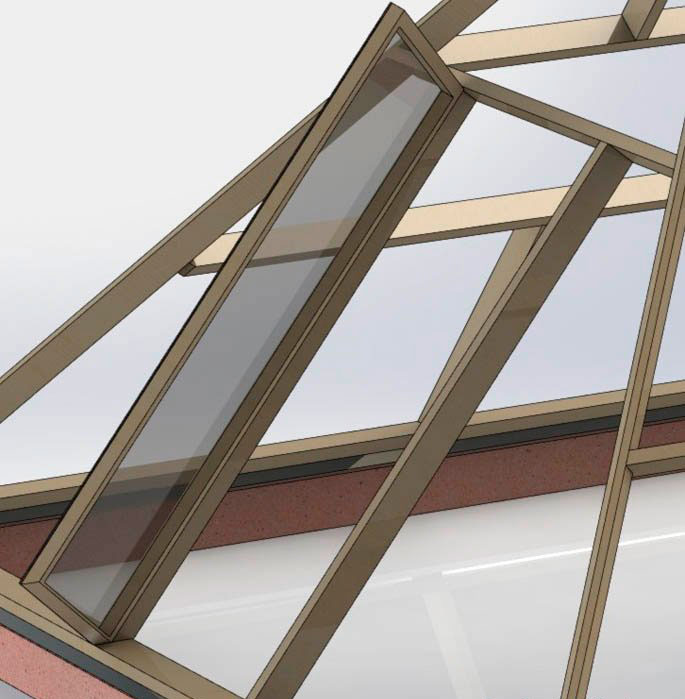
In the temperate climate zone, special designs help to achieve rich harvests. And one of them is a pyramid greenhouse, the dimensions of which are calculated according to the principle of pyramids erected in Ancient Egypt. This amazing structure is able to concentrate a strong energy field, due to which the plants are distinguished not only by good yields, but also by disease resistance.
A greenhouse in the form of a pyramid creates a special energy favorable for plant growth.
Today, greenhouses of this type are not as common as standard rectangular structures. Their design looks too complicated, but meanwhile you can make a greenhouse pyramid with your own hands. The main thing is to follow the rule of the "golden section": the ratio of the diagonal of the base to the height should be 0.62.
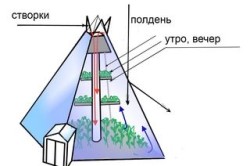
Figure 1. The device of the greenhouse in the form of a pyramid.
The pyramid design has a number of positive characteristics, such as:
Back to index

Structurally, the structure consists of 4 side frames connected together, mounted on a square base and covered with a film or polycarbonate. To give the frame additional rigidity, the frames are reinforced with wooden slats. In one of the frames there is an entrance door. For better ventilation on the opposite side of the door, you can build a window.
The dimensions of the greenhouse must correspond to the "golden section". Here you can make your own calculations or use already tested options. Many gardeners use the following indicators:
For independent calculations, a simple algorithm is used:
The drawings (Fig. 1) show what the pyramidal structure should look like. In this case, the ribs can be fixed on the base or stuck into the ground. Usually the height of the base is calculated depending on the height of the structure in a ratio of 1:3. So, a structure 3 m high has a base 1 m wide.
Back to index
With your own hands, you can build 2 types of pyramidal greenhouses: mobile or on a foundation.
The greenhouse should be oriented in a north-south direction to preserve the properties of the pyramid.
Mobile structures are convenient to use for growing seedlings. When the earth in the garden warms up, part of the seedlings is transferred to the beds. The other part can be left in the greenhouse.
To independently make a mobile pyramidal greenhouse, you will need:
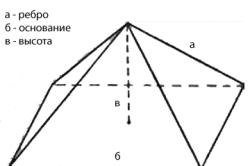
First of all, the size of the future structure is determined and the site is marked. The base of the structure must be strictly square. Then the prepared tubes or bars are stuck into the ground at the corners of the marking to a depth of about 40-50 cm. The upper parts of the tubes are connected to each other above the center of the square with a wire.
4 triangles are cut out of the film, which will serve as a coating for the side faces of the pyramid. At the bottom, the triangles should have a margin so that they can be pressed to the ground with boards. Already finished parts are attached to the frame with construction stapler brackets or special clamps.
An air vent is created at the top of the pyramid. To do this, the upper corners of the film triangles are bent to a height of about 10 cm. If necessary (frost, rain), the corners are bent and attached to the frame. One of the triangles must be fixed in such a way that it can be used as a door.
To achieve an excellent harvest, many gardeners build greenhouses. Such a greenhouse will allow you to get the long-awaited harvest a little earlier. Moreover, in such structures, several crops can be grown at once. Today, the pyramid greenhouse has become very popular. This article will tell you about what this design is, as well as how to build it yourself.
A pyramid-shaped greenhouse has the following positive characteristics:
In addition, inclined edges will act as a plus in such a greenhouse device. This allows you to achieve natural control over the amount of sunlight. The pyramidal design allows you to reflect a minimum of sunlight in the evening and in the morning, but in the afternoon they are reflected. As a result, plants grow in the most comfortable conditions for themselves.
This device allows you to control the humidity. To do this, it is enough to place a container of water inside the greenhouse. Another indisputable advantage that the pyramid greenhouse has is its mobility. For small buildings, it does not require pouring the foundation, which allows you to move them around the garden without much effort. Under it, you can even hide small trees from frost. In addition, such a greenhouse can also act as a kind of decoration for a vegetable garden or garden, complementing the country landscape of your home.
Before proceeding with the assembly of the greenhouse, it is necessary to determine its dimensions. Please note that if you have correctly determined the dimensions and drawn up a drawing, you can assemble such a greenhouse with your own hands in just half a day (they ate a medium-sized greenhouse and without a foundation).
The ideal cross section for a pyramid is 0.62. It is he who provides the maximum potential of the entire building in terms of energy. To get it, the greenhouse pyramid must have the following parameters:
Design calculation on the diagram
With such dimensions, the diagonal of the greenhouse will be 2 m. As a result, 200/320 = 0.62, which is what we needed. According to the indicated calculations, we create a drawing of the future structure, and we can proceed to its construction.
When all the necessary calculations have been carried out and the drawing is ready, we proceed to the construction:
Many experts recommend making four additional supports for each face. They will act as supports for the triangle sides of the pyramid. We make the entrance and the door frame from the south side. After that, the finished frame just needs to be covered with a film. You can also make walls out of polycarbonate. At the very top of the pyramid we make a cap (it will act as a ventilation window) or leave it about 30 cm open.
As you can see, making such a greenhouse with your own hands is quite easy and fast.
In a situation where you want to get not a portable greenhouse made of polycarbonate or film, but a permanent building, you need to make a foundation. It will also have to be filled in if the greenhouse device is large enough.
The foundation should be poured in the same way as for any other greenhouse. But here it must be remembered that the pyramid at the base must have a square.
The creation of the foundation is carried out according to the following scheme:
The result is a square foundation for the pyramid. Now you need to raise the frame in height. In this situation, the following manipulations should be carried out:
Then, at the base in the center of the pyramid, we make beds of slate. Their height is 80 cm. To prevent overheating of plants, the entrance should be made from the south side (as in a situation with no foundation). After that, we cover the resulting frame with a film or make a coating of cellular polycarbonate.
Thus, everyone can build a greenhouse in the shape of a pyramid on their backyard or garden. And what kind it will have (with or without a foundation) is already determined by you. Both devices have their own nuances in the assembly, but at the same time they do their job equally well.
This difficult task of any summer resident or gardener will not be so terrible after watching the videos that we have prepared for you. Check out all the secrets and tricks of this process. published
Join us at